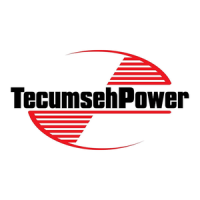
Do you have a question about the Tecumseh H35 and is the answer not in the manual?
| Power | 3.5 HP |
|---|---|
| Compression Ratio | 6.5:1 |
| Fuel Type | Gasoline |
| Ignition System | Magneto |
| Starting System | Recoil |
| Shaft Diameter | 3/4 inch |
| Shaft Orientation | Horizontal |
| Governor Type | Mechanical |
| Engine Type | air-cooled |
| Fuel Capacity | 1.5 quarts (1.4 liters) |
Locates and interprets Tecumseh engine model, specification, and serial numbers for identification.
Details the type of oil to use, capacities for different models, and recommended oil change intervals.
Provides essential precautions for storing engines with fuel, including draining or stabilizing fuel.
Guides on diagnosing engine performance problems potentially caused by a restricted or dirty air cleaner.
Provides a flowchart for diagnosing engine problems, starting with 'Engine Will Not Start'.
A detailed chart linking air, diaphragm, and fuel system problems to engine operating conditions.
Guides on testing carburetor performance by checking spark, fuel flow, and engine compression.
Explains carburetor pre-sets, adjustments, and notes on emission-grade carburetors.
Details how to check and adjust the float height for proper carburetor operation and engine starting.
Guides on diagnosing problems related to engine hunting, surging, or overspeeding.
Procedures for addressing engine overspeeding, including immediate shutdown and inspection.
Steps to stabilize engine RPM and diagnose issues causing surging or erratic speed.
Provides the procedure for adjusting the governor by setting the throttle shaft and clamp.
Guides on diagnosing and repairing starter problems by inspecting components for wear or breakage.
Explains the operation of the electric starter circuit and how the armature engages the flywheel.
Lists fundamental checks to perform before extensive electrical system diagnostics.
A flowchart to diagnose electrical starter circuit issues, from 'Starter will not turn' to 'engine bind'.
A flowchart to diagnose electrical charging circuit problems, checking voltage and components.
Detailed tests for the starting circuit, including power source, starter terminals, and wiring checks.
Instructions for testing various Tecumseh charging systems using wiring diagrams and voltmeters.
Tests for the DC adaptor using an ohmmeter to check the rectifier bridge continuity.
Checking the 3 Amp DC alternator system for fuse integrity and diode function.
Checking the 3 Amp DC alternator system with a diode in the harness sleeve for output voltage.
Checking the 5 Amp AC alternator system with regulator-rectifier under the blower housing.
Checking the combined 3 Amp DC (battery) and 5 Amp AC (lighting) alternator system.
Guidance on checking voltage regulators using a voltmeter to ensure proper battery charging.
Instructions for checking the function of Low Oil Shutdown (LOS) switches.
Covers service procedures for 12 and 120 volt electric starters, including disassembly and inspection.
Service procedures for electric starters with exposed shafts, including dust cover removal.
Service procedures for electric starters with a cap assembly, including retainer ring removal.
Guidance on inspecting starter components like pinion gears, brushes, and armatures for wear or damage.
Explains how the brake lever and pad stop the flywheel and actuate the ignition kill switch.
Service procedures for brake systems that fail to kill ignition or stop the blade within 3 seconds.
Procedures for removing, inspecting, and replacing the brake lever and pad assembly.
Checks and replacement procedures for the starter interlock switch, ensuring proper engagement.
Provides a flowchart for diagnosing ignition system problems, from 'Engine Will Not Start' to erratic running.
Methods for testing ignition system components like spark plugs, coils, and magnets.
Explains the importance of ignition timing for engine power and describes the standard point system.
Provides charts for diagnosing engine issues like knocks, overheating, surging, misfires, and oil consumption.
Troubleshooting steps for engine knocks, including checking equipment fit and ignition timing.
Steps to diagnose and resolve engine overheating, including checking load, oil, and cooling fins.
Troubleshooting for uneven engine operation, checking fuel cap vent, air filter, and linkages.
Steps to diagnose and fix engine misfires, including spark plug, carburetor, and valve checks.
General procedures for disassembling engine models, including removing flywheel, carburetor, and cylinder head.
Lists torque specifications for various engine components across different models.
Provides engine specifications for standard point ignition systems, including valve settings.
Lists engine specifications for solid state and external ignition systems, including air gap settings.
